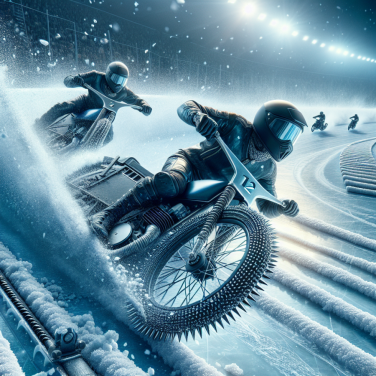Breaking Down Ice Hockey's Game Time: The Role of Periods
Ice hockey is a sport known for its fast pace and energetic play, and understanding how the game is structured can greatly enhance one’s appreciation for the strategic nuances of the sport. Central to hockey's structure is the division of play into periods. In this professional blog post, we will delve into the specifics of periods in ice hockey and what they mean for the game’s flow, strategy, and player performance.
Professional ice hockey games are typically divided into three main periods, each lasting 20 minutes. This division creates a clear structure for the game, providing start and stop points for play and allowing for intermissions and strategic regrouping. The clock only runs when the puck is in play, meaning that play can actually extend beyond the designated period length due to stoppages for penalties, goals, puck out of play, and other game events.
The first period serves as the opening chapter of the game, where teams come out with their game plans fresh and players are at their most energetic. Coaches often try to set a tone for the game during this period, whether that's establishing physical dominance, setting a fast pace, or testing the opposing team’s defense and goaltending.
Following the first period, the teams retreat to their respective locker rooms for an intermission. The break lasts about 15-18 minutes, allowing players to rest and coaches to provide feedback and adjust strategies. This is a crucial time for teams to analyze their performance and make necessary changes before the next stretch.
The second period presents unique challenges as the teams have now switched ends. This means longer changes for the players, as the benches are further from the defensive zone. Line changes require more coordination and can lead to pivotal mistakes or opportunities, depending on how well teams manage the greater distance to their bench. This is where the strategic depth of hockey really starts to shine, as teams need to be mindful of the risk of being caught during a line change.
The third and final period is often where the game is won or lost. Fatigue starts to set in, and the ability of the players to maintain focus and energy can significantly influence the outcome. Teams that are trailing work to mount a comeback, often increasing their offensive risk-taking. Conversely, teams in the lead may adopt a more defensive strategy to protect their advantage. The last minutes can become particularly intense if the score is close, sometimes leading to one team pulling their goaltender for an extra attacker in an all-out attempt to tie or win the game.
Read also:
Can Golf Clubs Get Wet? Understanding Your Equipment's Limits
Navigating the Clock: Duration and Dynamics of Ice Hockey Periods
In professional hockey, each game is divided into three main periods, each lasting twenty minutes. This is a standard set by major leagues, including the NHL, ensuring consistency in the gameplay experience across games and seasons. As players hit the ice, they are acutely aware of the significance of each period, forming strategies that evolve as the game progresses.
The first period is crucial for setting the tone. Both teams utilize this time to feel out their opponents, establish momentum, and try to secure the early advantage. Coaches may shuffle lines, looking for chemistry and opportunities that could give their team an edge. Players must balance aggression with discipline, as early penalties could tilt the ice in favor of their opponents.
As the buzzer signals the end of the initial frame, the dynamics of the game are often starting to reveal themselves. Teams head to the locker room for a respite and an opportunity to regroup. This intermission lasts about seventeen minutes in professional leagues. Coaches and players use this time to reassess tactics, tend to any equipment issues, and prepare for the next period.
In the second period, teams must adapt to the so-called "long change." The benches are farther from the defensive zone due to the switch of ends, making player changes more challenging and potentially resulting in more on-ice vulnerabilities. This period often sees a spike in scoring due to such defensive breakdowns and fatigue starting to set in. Teams might opt to play more defensively or aggressively based on the state of the game.
The final intermission mirrors the first, offering a similar pause for players to catch their breath and for coaches to deliver critical strategic adjustments. The energy in the locker room might vary greatly, pulsating with intensity if the score is close or potentially subdued if there's a clear leader. Either way, the final segment of the game looms, and the approach must be finely tuned.
The third period is where the game often reaches its peak intensity. Players are acutely aware of the clock ticking down, and for the team that's behind, every second is precious. Here is where endurance training, mental resilience, and the depth of the roster come into play. Coaches will often shorten their benches, giving more ice time to their top players in an effort to secure the game or make a comeback.
The dynamics of the third period can change dramatically if the score is close.
Understanding the structure of ice hockey is crucial for any fan or player seeking to fully comprehend and enjoy the sport. The game is divided into three primary segments called periods, which form the backbone of regulation play.
Each period in a professional ice hockey game, such as those in the National Hockey League (NHL), lasts for 20 minutes of stop-time play. This means the clock is stopped for various reasons including when a goal is scored, a penalty is called, or when the puck leaves the playing surface. This differs from sports like soccer where the clock continues to run through most stoppages in play. The precision of timing in ice hockey ensures that each period contains exactly 20 minutes of actual play time.
At the end of each period, there is an intermission. Typically, this break lasts about 17 minutes, though it may be extended during playoff games or special events. During this time, the ice is resurfaced by a Zamboni, providing a fresh playing surface for the players. It’s also a chance for players to rest, for coaches to strategize, and for fans to discuss the game and visit concessions.
Overtime and shootouts come into play if the game is tied at the end of the third period. In the regular season, the NHL uses a sudden-death overtime period which is five minutes long and played three-on-three. If the game remains tied after overtime, it progresses to a shootout. During the playoffs, there are no shootouts; instead, the game moves into 20-minute sudden-death overtime periods with full five-on-five play, continuing until someone scores.
These structured periods along with the breaks and potential overtime create a rhythm to the game that is unique to ice hockey. This rhythm allows for shifts in momentum, opportunities for comebacks, and builds in natural crescendos of tension and release that make ice hockey one of the most exciting sports to watch.
Understanding the time structure of ice hockey also helps in appreciating the energy and endurance required by the players. The stop-and-start nature of play requires intense bursts of energy and makes player rotations and line changes crucial strategic elements of the game. Coaches must be adept at managing their players’ energy and time on the ice, as fresh legs can make the difference in the fast-paced, physically demanding periods.
In summary, periods form the essential structural elements of a professional ice hockey game.




